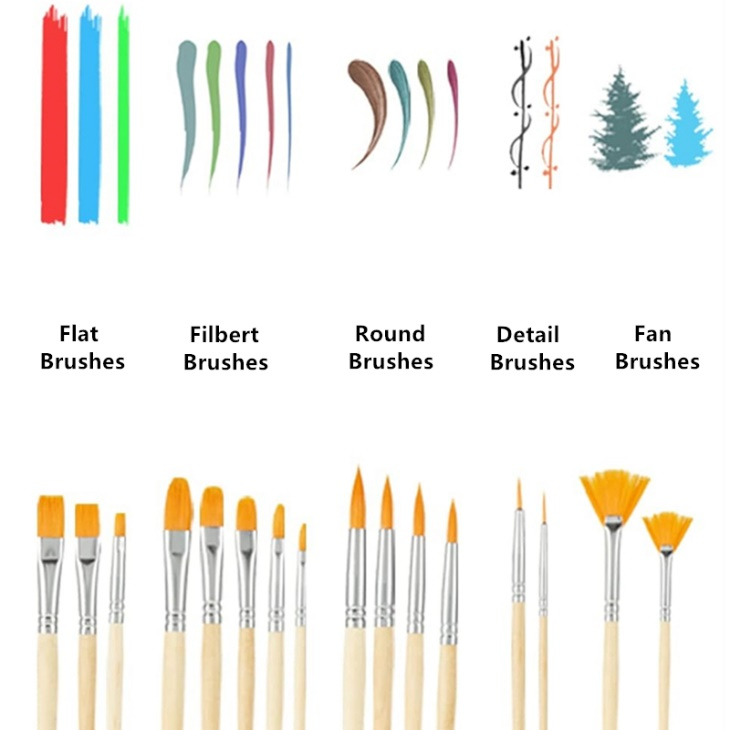Views: 18 Author: Site Editor Publish Time: 2024-12-20 Origin: Site








Acrylic painting is one of the most popular art forms today. Artists love it for its versatility, bright colors, and fast-drying nature. However, the type of brush you use can greatly affect the outcome of your painting. Choosing the right brush is key to achieving the textures, strokes, and finishes you want. In this article, we'll explore the best types of brushes for acrylic painting, offering a simple guide for both beginners and experienced artists.
In this guide, we’ll discuss the different brush materials, shapes, and sizes, and how each is used in acrylic painting. We’ll also share tips on how to care for your brushes to make them last longer. Understanding these basics will help artists make better choices, improving both their creativity and the quality of their work.
Brushes are made with two main types of bristles: natural and synthetic. Natural bristles, often from animals like hog, sable, or squirrel, are great at holding paint and water. They’re perfect for blending and creating smooth transitions. Synthetic fibers, made from materials like PET are more durable and resistant to wear. They are especially good for acrylic paints because they can handle the fast-drying, thick texture of acrylics.
Many acrylic artists prefer synthetic brushes because they hold their shape better with thick paint. Plus, synthetic brushes are eco-friendly and cruelty-free, which fits with the values of many modern artists.
Besides animal bristles and synthetic fibers, there is also a type of hybrid bristle that blends both natural and synthetic hairs. This combination offers the best of both materials. These brushes are versatile and work well for various techniques, making them an essential tool for any artist. They are especially useful for artists who work with different mediums, such as acrylics, oils, and watercolors.
Categories | Hair Type | Application | Technology | Features |
Animal Bristles | Hog Bristle | good for oil painting& acrylic painting | bleached hog bristles | With the best flexibility and water-absorbing quality, Chungking bristle is born to make high quality brush hair. |
Pony/Camel | good for watercolor and gouache painting | dry making | Easily broken | |
wet making(making the hair in the water) | Right way to make high quality brush hair & reduce possibility of broken | |||
Goat | good for watercolor and gouache painting | Seldom be chosen now | ||
Sable | Expensive & be born to make extreme high quality brush hair | |||
Synthetic Fibers | Korean or | can be used for most kinds of paintings | Korean or Japanese hair is recommended to make high quality brush. We can also mix hair of different diameters or mix nylon hair and bristle together based on your requirements. | |
Domestic hair |

When it comes to acrylic painting, the shape of your brush plays a big role in the techniques and effects you can achieve. Different brush shapes are designed for specific purposes, from fine details to broad strokes, blending, and texture creation. Here's an easy-to-understand guide to the most common brush shapes and their uses.
Round brushes are the most versatile. They have a pointed tip, which makes them perfect for detailed work like fine lines, outlines, and small details. The body of the brush holds enough paint for broader strokes, making it useful for both precision and larger areas. They are great for creating intricate patterns and controlled strokes in acrylic painting.
Flat brushes have square-shaped bristles and are ideal for bold, straight strokes. They are perfect for filling large areas with paint and creating sharp, defined edges. These brushes are often used for backgrounds, washes, and geometric patterns. You can also use the flat edge to create fine lines by turning the brush sideways.
Filbert brushes combine the features of both round and flat brushes. Their rounded edge makes them great for blending and creating soft, smooth transitions. Filbert brushes are popular among portrait and landscape artists for their ability to make both detailed and broader strokes. Their versatility makes them ideal for various painting techniques.
Fan brushes have a unique shape that spreads out like a fan. They are mainly used for blending, feathering, and creating natural textures, like foliage, clouds, and hair. The fan shape allows you to apply paint in a way that mimics organic patterns, adding depth and texture to your artwork.
Detail brushes are small and precise, designed for intricate work such as highlights, fine lines, and tiny details. These brushes are essential for artists who focus on realism and need to capture the smallest elements in their paintings.
Some brush sets have the same shape but come in different sizes, while others are assorted shapes, containing several commonly needed shapes. Consumers can choose different products based on their specific needs.
Choosing the right brushes for acrylic painting is all about understanding what works best for your style and needs. Whether you prefer the durability of synthetic bristles or the smooth blending of natural ones, the goal is to pick brushes that help you achieve your creative vision. Explore a variety of brushes in the Artist Brush collection to find the perfect tools for your next masterpiece.
Investing in quality brushes and taking good care of them will improve your artwork and keep your tools reliable for years. The right brushes make the acrylic painting process more enjoyable, enhancing both your creativity and the final result.
content is empty!